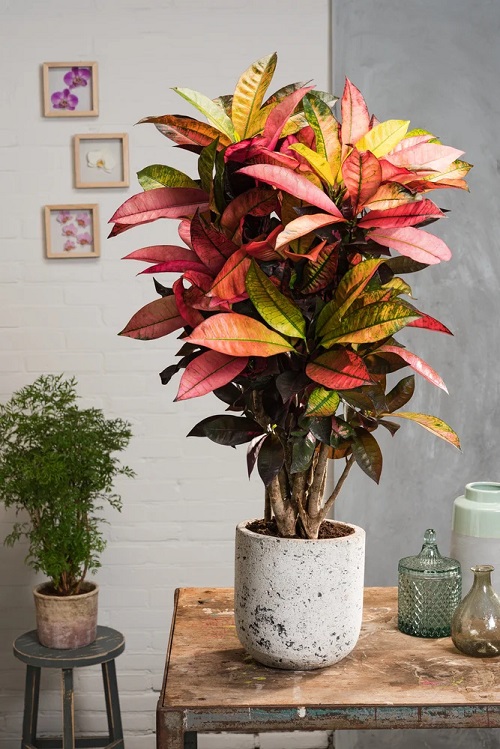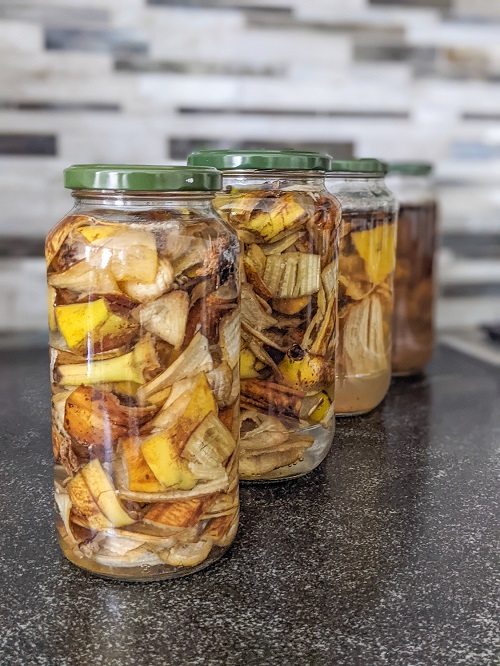Want your plants to showcase beautiful hues? Here is how to Use Banana Peels to Grow the Most Colorful Crotons!
Discover the secret to Use Banana Peels to Grow the Most Colorful Crotons. Uncover the natural power of banana peels as a booster for your crotons, unlocking a world of the most vivid and vibrant Crotons.
Here are the Best Ways to Propagate Croton Easily
Why Use Banana Peels for Colorful Crotons?
Banana peels are rich in potassium, which is essential for promoting healthy growth and vibrant foliage in Crotons. Banana peels help in the following.
- Potassium Boost: Crotons require an ample supply of potassium for healthy growth and vibrant foliage. Banana peels, being a potassium-rich organic source, provide a natural and sustainable way to meet this need.
- Improved Color Intensity: The nutrients present in banana peels promote chlorophyll production, enhancing the intensity of croton leaf colors. This results in more vivid and striking foliage.
- Root Development and Plant Health: The phosphorus and calcium found in banana peels aid in root development, strengthening the overall health and resilience of croton plants.
Different Ways to Use Banana Peels for Croton Plants
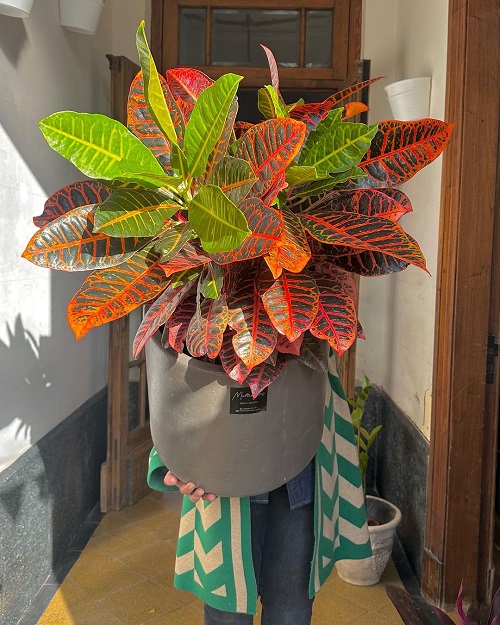
- Compost: The best way to use banana peels is to compost them with other kitchen scraps and garden waste. Once decomposed, the compost can be added to your potting soil or garden beds. Compost will improve the quality of your soil, and the nutrients from the banana peels will be available to your croton plants.
- Banana Peel Tea: You can also soak banana peels in water for a few days to create “banana peel tea.” This nutrient-rich water can be used to water your plants, providing them with an instant nutrient boost.
- Direct Application: Some people choose to cut up banana peels and mix them directly into the soil. If you choose this method, be sure to chop the peels very finely so they break down more quickly.
Important: Croton plants require micronutrients like magnesium and iron for vibrant leaf coloration. While banana peels do contain these nutrients, they’re not present in particularly high quantities. If your croton plant’s leaves are less colorful than desired, it’s also essential to consider factors like light exposure, overall soil quality, and whether the plant has any diseases or pests.
Do you Want to Know How to Grow Big Croton Like a Tree? Read here
How to Use Banana Peels to Grow the Most Colorful Crotons
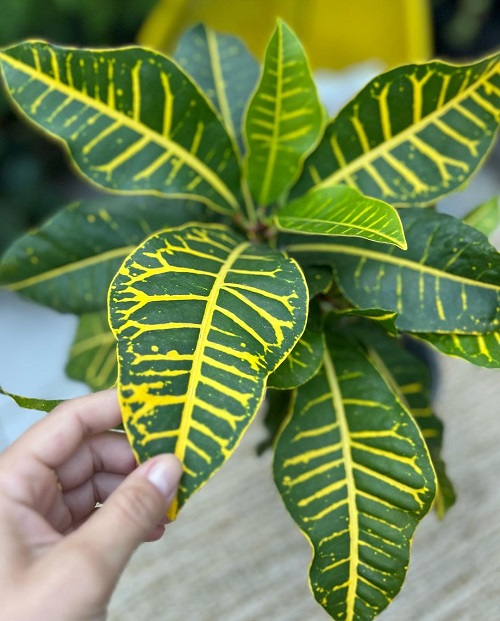
1. Gather and Prepare Nutrient-Rich Banana Peels
Start by collecting ripe banana peels, ensuring they are free from any fruit residue. To accelerate nutrient release, cut the peels into small pieces. This simple step helps break down the peels faster, allowing the Crotons to absorb the valuable nutrients more efficiently.
2. Apply the Banana Peels on Croton
Once you have gathered the banana peels and divided them into smaller pieces, it is time to let your Croton plants reap the benefits. There are two ways you can do this.
Direct Application Method:
- Take the prepared banana peels and place them around the base of your Croton plants, avoiding direct contact with the stems.
- Spread the peels in a thin layer, covering the soil surrounding the plants.
- Direct application turns the banana peels into a slow-release fertilizer, gradually nourishing the Crotons with essential nutrients and improving their color.
Enhance Decomposition with Mulching:
- Maximize the benefits of banana peels by adding a layer of organic mulch, such as wood chips or dried leaves, over the peels.
- The mulch helps retain moisture in the soil and promotes favorable decomposition of the peels, enriching the Croton’s root zone.
- Mulching also aids in weed control and maintains a stable soil temperature, creating a nourishing environment to grow the most colorful Croton.
Learn a few unknown secrets of colorful croton plants here
3. Adequate Watering and Regular Maintenance
Proper watering is crucial to activate the decomposition process and ensure the release of nutrients from the banana peels. Keep the soil consistently moist, but avoid overwatering, as excessive moisture can lead to root rot.
You should regularly monitor the soil moisture level and adjust your watering schedule accordingly. Additionally, conduct routine maintenance such as removing any decaying or moldy banana peels to maintain a healthy and clean growing environment for Croton.
Here are the best ways to water plants
4. Re-application for Long-Term Results
Over time, the banana peels will showcase their importance and turn your Croton leaves colorful and vibrant. However, if you want to achieve continuous vibrant foliage, make a habit of regularly applying banana peels every two to three months during the Crotons’ active growth period.
The active growth period for Croton typically occurs during the spring and summer months. As the weather warms up and daylight hours increase, crotons experience a surge in growth and vitality. With a consistent supply of nutrients from the banana peels, the Croton will sustain their health, and you will enjoy the intensity of their leaf colors.
Note: Avoid using the banana peels in excess. You should strike a balance and avoid excessive application (More than once every 2-3 months), as nutrient imbalances can be detrimental to the plant’s well-being.
Know everything about growing croton as a houseplant here
Making Banana Peel Fertilizer for Colorful Crotons
You can easily turn banana peels into fertilizer for Crotons and other plants.
- Chop the banana peels into small pieces, ensuring they are no more than 1-2 inches wide.
- Place the chopped peels in a sunny spot to dry for 5-7 days. Alternatively, you can dry them in the oven at a low temperature with the door open.
- Once the peels are dry, grind them into a fine powder.
- Mix the banana peel powder into the growing medium. Use 2-4 spoons for small pots and adjust the amount accordingly for larger pots.
Utilizing banana peels as a natural fertilizer is an eco-conscious choice, reducing the need for synthetic alternatives and minimizing waste.
Here is a Super Quick Banana Peel Powder Fertilizer Recipe for More Flowers
Quick Tips to Grow the Most Colorful Crotons
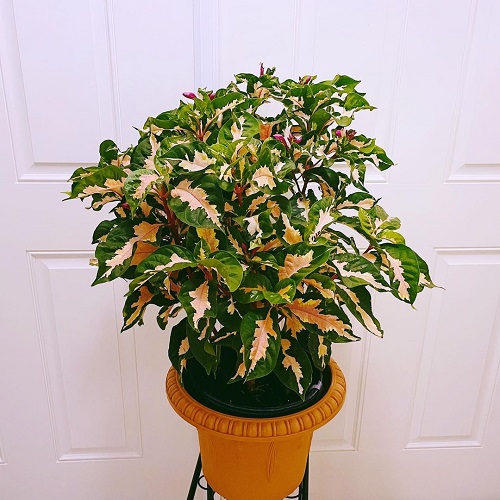
- Place crotons in a location with bright, indirect sunlight. This helps promote vibrant leaf colors and prevents leaf burn.
- Maintain a regular watering schedule to keep the soil evenly moist. Crotons prefer slightly moist soil but are sensitive to overwatering.
- Use well-draining soil that allows excess water to flow through easily. This helps prevent waterlogged roots and maintains proper oxygen levels.
- Crotons thrive in warm temperatures between 60-85°F (15-29°C). Protect them from cold drafts or sudden temperature fluctuations.
- Keep an eye out for common pests like mealybugs, scale insects, and spider mites. Regularly inspect your crotons and take appropriate measures to keep these at bay.
Have a look at the best types of crotons to grow here
Frequently Asked Questions
1. Can I Use Banana Peels for Other Plants?
Absolutely! Banana peels offer benefits to a wide range of plants beyond crotons. Roses, tomatoes, and peppers, among others, can all benefit from the nutrients present in banana peels.
Here is a Dried Banana Peel Powder Fertilizer at Home for Any Plant
2. Will Banana Peels Attract Pests or Insects?
Banana peels are generally safe from attracting pests. They do not typically invite unwanted visitors to your plants. However, it’s always important to keep an eye on your plants and be proactive in pest control measures as needed.
Here are the Best Organic Pest Control Approaches Every Gardener Should Know
3. Can I Use Banana Peels for Potted Croton Plants?
Certainly! Utilizing banana peels for potted croton plants is an excellent way to provide them with essential nutrients and grow the most colorful crotons. To do so, simply chop the banana peels into smaller pieces and mix them into the potting soil.

